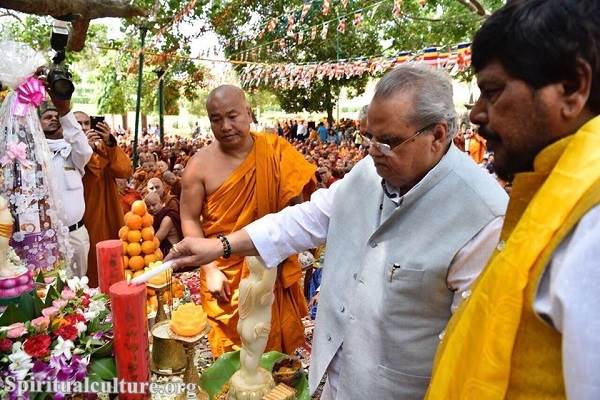Buddhism is a profound spiritual tradition that has influenced millions of people around the world for over two and a half millennia. With its roots in ancient India, Buddhism offers a path to understanding the nature of suffering and the means to overcome it, leading to enlightenment and inner peace.
In this article, Spiritual Culture provides an in-depth exploration of the key principles of Buddhism, tracing its historical development, core teachings, major concepts, practices, and the diverse schools that have emerged over the centuries. We also examine the role of the Buddhist community, or Sangha, and the modern relevance of Buddhism in a globalized world.
Historical Context of Buddhism
Origins of Buddhism
The origins of Buddhism can be traced back to the 6th century BCE in the region that is now modern-day Nepal and northern India. The founder of Buddhism, Siddhartha Gautama, was born into a royal family in the Shakya clan. His early life was one of luxury, shielded from the harsh realities of the world. However, as he grew older, Siddhartha encountered the “Four Sights”—an old man, a sick man, a dead man, and a wandering ascetic. These encounters profoundly disturbed him and led him to question the transient nature of life and the inevitability of suffering.

At the age of 29, Siddhartha renounced his royal life and embarked on a quest for spiritual understanding. He spent years practicing severe austerities, but these extreme practices did not lead to the enlightenment he sought. Eventually, he abandoned asceticism and pursued a middle path of moderation and meditation. After years of deep meditation, Siddhartha attained enlightenment under the Bodhi tree in Bodh Gaya. He became the Buddha, or “the Awakened One,” and dedicated the rest of his life to teaching the principles of enlightenment to others.
Development of Early Buddhist Thought
The Buddha’s teachings, known as the Dharma, were initially transmitted orally by his disciples and later compiled into texts known as the Pali Canon, or Tipitaka. These texts are considered the earliest and most authoritative scriptures in Theravada Buddhism. The Dharma emphasized the importance of understanding the nature of suffering, known as Dukkha, and the path to its cessation.
Early Buddhist thought was characterized by its practical approach to spiritual development. The Buddha taught that enlightenment could be attained through personal experience, ethical conduct, and mental discipline. This emphasis on individual practice and self-reliance set Buddhism apart from other religious traditions of the time, which often relied on rituals and the intervention of deities.
As Buddhism spread across India and beyond, different interpretations of the Buddha’s teachings emerged. These interpretations led to the formation of various schools of thought, each with its own emphasis and practices. Despite these differences, all schools of Buddhism share a common foundation in the core teachings of the Buddha.
Influence of Cultural and Social Factors
The spread and development of Buddhism were profoundly influenced by the cultural and social contexts of the regions it reached. In India, Buddhism interacted with the existing Vedic and Hindu traditions, adopting and adapting certain concepts while rejecting others. For instance, the idea of karma and rebirth was incorporated into Buddhist thought, but the caste system was rejected in favor of a more egalitarian approach to spiritual development.
As Buddhism spread to other parts of Asia, such as China, Japan, Korea, and Tibet, it encountered different cultural and philosophical traditions. In China, for example, Buddhism encountered Confucianism and Daoism, leading to the development of distinct schools such as Chan (Zen in Japan), which emphasized meditation and direct experience over doctrinal study. In Tibet, Buddhism absorbed elements of the indigenous Bon religion, resulting in the unique practices and rituals of Vajrayana Buddhism.
The social factors of the time also played a crucial role in the spread of Buddhism. The support of rulers, such as Emperor Ashoka in India, who converted to Buddhism and helped promote its teachings throughout his empire, was instrumental in establishing Buddhism as a major religious tradition. The establishment of monastic communities, or Sanghas, provided a stable environment for the preservation and transmission of the Buddha’s teachings.
Core Teachings
The Four Noble Truths
At the heart of Buddhism lie the Four Noble Truths, which form the foundation of the Buddha’s teachings. These truths provide a framework for understanding the nature of suffering and the path to liberation.
- The Truth of Suffering (Dukkha): The first Noble Truth acknowledges that suffering is an inherent part of existence. This suffering is not limited to physical pain or emotional distress but also includes the subtle dissatisfaction and impermanence that permeate all aspects of life. The recognition of Dukkha is the first step towards awakening, as it motivates individuals to seek a solution to the pervasive problem of suffering.
- The Truth of the Cause of Suffering (Samudaya): The second Noble Truth identifies the cause of suffering as craving or attachment (tanha). This craving arises from a misunderstanding of the nature of reality, leading individuals to cling to things that are impermanent and ultimately unsatisfactory. The Buddha taught that by understanding the causes of craving and overcoming them, one could put an end to suffering.
- The Truth of the Cessation of Suffering (Nirodha): The third Noble Truth states that it is possible to end suffering by eliminating craving and attachment. This state of liberation is known as Nirvana, a condition of complete freedom from the cycle of birth, death, and rebirth (samsara). Nirvana represents the ultimate goal of the Buddhist path, where the fires of desire, aversion, and ignorance are extinguished.
- The Truth of the Path to the Cessation of Suffering (Magga): The fourth Noble Truth outlines the Noble Eightfold Path, which provides a practical guide for ethical and mental development, leading to the cessation of suffering. This path is often divided into three categories: wisdom (prajna), ethical conduct (sila), and mental discipline (samadhi). By following this path, individuals can gradually reduce their suffering and move closer to enlightenment.
The Noble Eightfold Path
The Noble Eightfold Path is the practical aspect of Buddhist teachings, offering a comprehensive guide for living a life that leads to enlightenment. Each aspect of the path is interconnected, and together they provide a holistic approach to spiritual development.
- Right Understanding (Samma Ditthi): Right Understanding involves comprehending the true nature of reality, including the Four Noble Truths and the Law of Karma. It requires a deep understanding of the impermanent, unsatisfactory, and non-self nature of all phenomena.
- Right Intent (Samma Sankappa): Right Intent refers to the cultivation of wholesome thoughts and intentions. This includes intentions of renunciation, goodwill, and harmlessness. By aligning one’s intentions with the principles of non-attachment and compassion, individuals can overcome the negative impulses that lead to suffering.
- Right Speech (Samma Vaca): Right Speech emphasizes the importance of speaking truthfully, kindly, and constructively. It involves abstaining from lying, divisive speech, harsh words, and gossip. By practicing Right Speech, individuals contribute to a harmonious and peaceful community.
- Right Action (Samma Kammanta): Right Action involves ethical conduct through actions that are morally sound. This includes abstaining from harming living beings, stealing, and engaging in sexual misconduct. Right Action is essential for creating positive karma and living in harmony with others.
- Right Livelihood (Samma Ajiva): Right Livelihood encourages individuals to engage in work that is ethical and does not cause harm to others. This means avoiding professions that involve killing, exploitation, or deceit. Right Livelihood supports a life of integrity and ethical consistency.
- Right Effort (Samma Vayama): Right Effort involves the cultivation of positive mental states and the prevention of unwholesome ones. This includes developing virtues such as mindfulness, concentration, and loving-kindness while avoiding negative emotions like greed, anger, and ignorance.
- Right Mindfulness (Samma Sati): Right Mindfulness is the practice of being fully present and aware of one’s thoughts, feelings, and actions. It involves maintaining awareness of the body, sensations, mind, and mental phenomena. Mindfulness is a key practice in Buddhism, helping individuals to observe their experiences without attachment or judgment.
- Right Concentration (Samma Samadhi): Right Concentration refers to the practice of deep meditation, where the mind is focused and tranquil. This state of concentration is essential for developing insight into the nature of reality and attaining the higher stages of meditation, leading to enlightenment.
The Law of Karma
The Law of Karma is a central concept in Buddhism, stating that every action, whether physical, verbal, or mental, has consequences. Karma is not a system of punishment or reward but rather a natural law of cause and effect. Good actions, motivated by generosity, compassion, and wisdom, lead to positive outcomes, while negative actions, driven by greed, hatred, and delusion, result in suffering.
Karma operates across lifetimes, influencing not only one’s present life but also future rebirths. The accumulation of positive or negative karma determines the circumstances of one’s future existence. Understanding the Law of Karma encourages Buddhists to live ethically and mindfully, knowing that their actions have far-reaching implications. By generating positive karma, individuals can improve their current life and work towards a favorable rebirth.
Major Concepts
Impermanence (Anicca)
Impermanence, or Anicca, is one of the three marks of existence in Buddhism, along with suffering (Dukkha) and non-self (Anatta). Anicca refers to the constant state of change that characterizes all phenomena, whether they are physical objects, thoughts, or emotions. Nothing in the universe remains the same; everything is in a continuous process of arising and passing away.
The recognition of impermanence is essential for developing wisdom in Buddhism. By understanding that all things are transient, individuals can reduce their attachment to worldly possessions, relationships, and even their own identity. This understanding helps to cultivate a sense of detachment, leading to a reduction in suffering.
Impermanence also plays a crucial role in meditation practice. By observing the changing nature of thoughts and sensations, meditators can develop insight into the impermanent and conditioned nature of all phenomena. This insight is a key step towards attaining enlightenment.
No-Self (Anatta)
The concept of Anatta, or No-Self, is one of the most challenging and profound teachings in Buddhism. It challenges the conventional belief in a permanent, unchanging self or soul. According to Buddhist teachings, what we perceive as the “self” is merely a collection of five aggregates (skandhas): form, sensation, perception, mental formations, and consciousness. These aggregates are constantly changing and interdependent, and there is no enduring “self” to be found within them.
The realization of Anatta is a crucial step on the path to enlightenment. By understanding the illusory nature of the self, individuals can overcome the ego-driven desires and attachments that lead to suffering. This realization also helps to cultivate compassion, as the boundaries between self and others become less rigid.
Anatta is closely related to the concept of dependent origination (Paticca-Samuppada), which explains how all phenomena arise in dependence on causes and conditions. The understanding of Anatta and dependent origination leads to a deeper appreciation of the interconnectedness of all life and the impermanent nature of existence.
Suffering (Dukkha)
Dukkha is a fundamental concept in Buddhism, often translated as suffering, dissatisfaction, or unsatisfactoriness. It is the first of the Four Noble Truths and refers to the inherent unsatisfactoriness of life. Dukkha encompasses a wide range of experiences, from physical pain and emotional distress to the more subtle sense of unease that arises from the impermanent and conditioned nature of all phenomena.
The Buddha taught that Dukkha is an inevitable part of existence, but it can be understood and transcended through the practice of the Noble Eightfold Path. The recognition of Dukkha motivates individuals to seek liberation from the cycle of birth, death, and rebirth (samsara) and to attain the state of Nirvana, where suffering ceases.
In addition to the general suffering experienced in life, Buddhism also identifies three specific types of Dukkha:
- Dukkha-Dukkha: The suffering of suffering, which includes physical pain, illness, and mental distress.
- Viparinama-Dukkha: The suffering of change, which arises from the impermanence of all things, including pleasure, relationships, and life itself.
- Sankhara-Dukkha: The suffering of conditioned existence, which refers to the subtle sense of dissatisfaction that arises from the fact that all phenomena are dependent on causes and conditions.
Understanding Dukkha and its causes is essential for developing insight into the nature of reality and progressing on the path to enlightenment.
Practices and Rituals
Meditation Techniques
Meditation is a central practice in Buddhism, used to cultivate mindfulness, concentration, and insight. There are various meditation techniques in Buddhism, each with its own focus and purpose. The two most widely practiced forms of meditation are Vipassana (insight meditation) and Samatha (calm-abiding meditation).
- Vipassana Meditation: Vipassana, or insight meditation, is a practice aimed at developing a deep understanding of the true nature of reality. In Vipassana, meditators observe the arising and passing away of thoughts, sensations, and emotions with mindfulness and equanimity. This practice helps to cultivate insight into the impermanent, unsatisfactory, and non-self nature of all phenomena. Through sustained practice, Vipassana leads to the gradual weakening of attachment and the development of wisdom.
- Samatha Meditation: Samatha, or calm-abiding meditation, focuses on developing concentration and tranquility of mind. In Samatha, meditators typically concentrate on a single object, such as the breath, a mantra, or a visual image, to stabilize the mind and achieve a state of deep calm. This practice helps to calm the mental chatter and distractions that often hinder meditation. Once a sufficient level of concentration is achieved, meditators can transition to Vipassana practice to develop insight.
- Metta Meditation: Another important meditation practice in Buddhism is Metta, or loving-kindness meditation. In Metta meditation, practitioners cultivate feelings of love, compassion, and goodwill towards themselves and others. This practice helps to reduce negative emotions such as anger and jealousy and promotes a sense of connection and compassion towards all beings.
Meditation is not only a practice for monastics but also for lay practitioners. It can be done in formal settings, such as meditation retreats or temples, or as part of daily life. The ultimate goal of meditation in Buddhism is to develop the mental clarity and insight necessary for attaining enlightenment.
Mindfulness and Awareness
Mindfulness, or the practice of being fully present in the moment, is a key aspect of Buddhist practice. It involves maintaining awareness of one’s thoughts, feelings, bodily sensations, and surroundings without attachment or judgment. Mindfulness is not just a meditation technique but a way of living that permeates all aspects of life.
In Buddhism, mindfulness is often practiced through the Four Foundations of Mindfulness (Satipatthana), which include:
- Mindfulness of the Body (Kaya-Sati): This involves paying attention to the body, including breathing, postures, movements, and physical sensations. Mindfulness of the body helps to ground the mind and develop an awareness of the physical aspect of existence.
- Mindfulness of Feelings (Vedana-Sati): This involves observing feelings or sensations that arise in response to sensory experiences. Feelings can be pleasant, unpleasant, or neutral. By being mindful of feelings, practitioners can avoid reacting impulsively to them and develop a more balanced mind.
- Mindfulness of the Mind (Citta-Sati): This involves observing the state of the mind, including thoughts, emotions, and mental patterns. Mindfulness of the mind helps to develop self-awareness and recognize the transient and conditioned nature of mental states.
- Mindfulness of Mental Objects (Dhamma-Sati): This involves observing the mental phenomena, including thoughts, concepts, and the principles of Buddhist teachings. Mindfulness of mental objects helps to deepen one’s understanding of the Dharma and apply it in daily life.
Mindfulness is a powerful tool for cultivating insight and reducing suffering. It helps individuals to live more consciously, respond to challenges with wisdom and compassion, and develop a deeper connection to the present moment.
Ethical Precepts in Daily Life
Ethical conduct is a fundamental aspect of Buddhist practice, guiding how individuals interact with others and the world. The Five Precepts are the basic ethical guidelines that all Buddhists are encouraged to follow. These precepts serve as a foundation for moral behavior and help to create positive karma.
The Five Precepts are:
- Abstaining from Killing: This precept involves refraining from taking the life of any living being, whether human or animal. It promotes compassion and respect for all forms of life.
- Abstaining from Stealing: This precept involves refraining from taking what is not freely given. It encourages honesty, fairness, and respect for the property of others.
- Abstaining from Sexual Misconduct: This precept involves refraining from harmful or exploitative sexual behavior. It promotes respect, responsibility, and fidelity in relationships.
- Abstaining from Lying: This precept involves refraining from false speech, including lying, gossiping, and speaking harshly. It encourages truthfulness, kindness, and integrity in communication.
- Abstaining from Intoxicants: This precept involves refraining from using substances that cloud the mind, such as alcohol and drugs. It promotes clarity of mind, self-control, and mindfulness.
In addition to the Five Precepts, there are other ethical guidelines that apply to monastics, such as the Vinaya rules, which govern monastic discipline. These rules help to maintain the purity and integrity of the monastic community and support the spiritual development of its members.
Ethical conduct in Buddhism is not based on a system of divine commandments but on the understanding of karma and the interconnectedness of all life. By living ethically, individuals contribute to the well-being of others and create the conditions for their own spiritual progress.
Variations and Schools of Buddhism
Theravada Buddhism
Theravada Buddhism, often referred to as the “Teaching of the Elders,” is the oldest surviving school of Buddhism. It traces its origins to the earliest teachings of the Buddha and is primarily practiced in Sri Lanka, Thailand, Burma (Myanmar), Cambodia, and Laos.
Theravada emphasizes the importance of individual effort and the study of the Pali Canon, which is considered the most authoritative collection of the Buddha’s teachings. The goal of Theravada practice is to achieve Nirvana, the cessation of suffering, through the practice of the Noble Eightfold Path and the cultivation of wisdom (prajna).
Monastic life is highly valued in Theravada Buddhism, and monks play a central role in preserving and transmitting the teachings. Lay practitioners support the monastic community through offerings and in return receive guidance and blessings.
Theravada meditation practices, such as Vipassana and Samatha, are widely taught and practiced, both by monastics and laypeople. The emphasis on mindfulness and insight into the nature of reality has made Theravada meditation practices popular worldwide, especially in the context of mindfulness-based stress reduction (MBSR) programs.
Mahayana Buddhism
Mahayana Buddhism, known as the “Great Vehicle,” is a broad tradition that encompasses a wide range of schools and practices. It originated in India several centuries after the Buddha’s death and spread to East Asia, including China, Japan, Korea, and Vietnam.
Mahayana emphasizes the ideal of the Bodhisattva, an enlightened being who forgoes final Nirvana to help others attain enlightenment. The Bodhisattva’s path is characterized by the practice of the Six Perfections (Paramitas): generosity, ethics, patience, effort, concentration, and wisdom.
Mahayana Buddhism includes various schools, each with its own teachings and practices. Some of the most well-known Mahayana schools are:
- Zen Buddhism: Zen emphasizes direct experience and meditation over doctrinal study. It is known for its practice of Zazen (sitting meditation) and the use of Koans (paradoxical riddles) to break through conventional thinking and attain sudden enlightenment.
- Pure Land Buddhism: Pure Land focuses on devotion to Amitabha Buddha and the aspiration to be reborn in the Pure Land, a realm of bliss where it is easier to attain enlightenment. Pure Land practices often involve chanting the name of Amitabha Buddha (Nembutsu) as an expression of faith.
- Tibetan Buddhism: Tibetan Buddhism, also known as Vajrayana or the “Diamond Vehicle,” is a unique tradition that combines elements of Mahayana with Tantric practices. It includes elaborate rituals, visualizations, and the use of sacred symbols (mandalas) to achieve spiritual transformation. The Dalai Lama, the spiritual leader of Tibetan Buddhism, is one of the most well-known figures in the Buddhist world.
Mahayana Buddhism also emphasizes the concept of Emptiness (Sunyata), which teaches that all phenomena are empty of inherent existence. This understanding of Emptiness is central to the development of wisdom and the realization of the interdependent nature of all life.
Vajrayana Buddhism
Vajrayana Buddhism, also known as Tantric Buddhism, is a unique and esoteric branch of Buddhism that developed within the Mahayana tradition. Vajrayana means the “Diamond Vehicle” or the “Thunderbolt Vehicle,” reflecting its emphasis on the indestructible and transformative nature of the teachings.
Vajrayana is primarily practiced in Tibet, Bhutan, and parts of Nepal and India. It incorporates many of the foundational teachings of Mahayana Buddhism but adds a rich array of rituals, symbols, and esoteric practices designed to accelerate the path to enlightenment.
Key elements of Vajrayana practice include:
- Deity Yoga: Practitioners visualize themselves as a particular enlightened being (yidam) and recite associated mantras. This practice helps to purify the mind and develop the qualities of the deity, such as compassion, wisdom, and strength.
- Tantric Rituals: Vajrayana rituals involve the use of mandalas, mudras (sacred hand gestures), and mantras (sacred sounds) to connect with the enlightened mind and transform ordinary perception into a vision of pure reality.
- Guru Devotion: In Vajrayana, the relationship with the spiritual teacher (guru or lama) is of utmost importance. The guru is seen as the embodiment of the Buddha’s wisdom and is essential in guiding the practitioner on the path.
- Bardo Teachings: Vajrayana includes teachings on the intermediate state (bardo) between death and rebirth. These teachings provide guidance on how to navigate the bardo and attain liberation or a favorable rebirth.
Vajrayana Buddhism is known for its complexity and depth, requiring the guidance of a qualified teacher. It is considered a powerful and effective path to enlightenment but also one that demands a high level of commitment and understanding.
Sangha: The Buddhist Community
Role of the Sangha
The Sangha, or the Buddhist community, plays a central role in the practice and preservation of Buddhism. The Sangha consists of both monastic members (monks and nuns) and lay practitioners. The monastic Sangha is responsible for maintaining the purity of the teachings, providing guidance to laypeople, and performing rituals and ceremonies.
Monks and nuns take vows of celibacy, simplicity, and ethical conduct, dedicating their lives to the study and practice of the Dharma. They rely on the lay community for material support, such as food, clothing, and shelter. In return, they offer spiritual teachings, blessings, and a living example of the Buddhist path.
The lay Sangha, on the other hand, is composed of everyday practitioners who follow the Five Precepts and integrate Buddhist teachings into their daily lives. Laypeople often support the monastic community through donations and by participating in rituals and meditation practices.
The relationship between the monastic and lay Sangha is symbiotic, with each supporting the other in their spiritual journey. The Sangha as a whole is considered one of the Three Jewels of Buddhism, alongside the Buddha and the Dharma. Taking refuge in the Sangha is a key aspect of Buddhist practice, signifying a commitment to the path of enlightenment.
Monastic Life
Monastic life is highly respected in Buddhism and is seen as the most conducive environment for spiritual development. Monks and nuns live in communities known as monasteries, where they engage in meditation, study, and communal activities. The monastic code, known as the Vinaya, governs all aspects of monastic life, from daily routines to ethical conduct.
Monastics follow a strict schedule that includes periods of meditation, chanting, and study of the scriptures. They also perform rituals, lead ceremonies, and offer teachings to the lay community. The simplicity and discipline of monastic life are designed to reduce distractions and foster the development of mindfulness, concentration, and insight.
Monastic life also involves acts of service, such as teaching, caring for the sick, and performing rituals for the deceased. These activities help to cultivate compassion and selflessness, which are essential qualities on the path to enlightenment.
Lay Practice
Lay practitioners play a vital role in the Buddhist community, supporting the monastic Sangha and integrating the teachings into their daily lives. Lay practice involves observing the Five Precepts, participating in rituals and ceremonies, and engaging in meditation and mindfulness practices.
Laypeople often visit monasteries and temples to make offerings, receive teachings, and participate in community events. They may also engage in charitable activities, such as supporting the poor and sick, as a way of generating positive karma.
In addition to their own practice, lay Buddhists are encouraged to share the teachings with others and contribute to the preservation and transmission of the Dharma. Lay practice is seen as a way to cultivate virtues, develop wisdom, and progress on the path to enlightenment, even within the context of a busy and active life.
Modern Relevance of Buddhism
Buddhism in the Global Context
Buddhism has become a global religion, with followers in nearly every country. The spread of Buddhism to the West in the 20th century has led to a resurgence of interest in its teachings and practices, particularly in the areas of meditation, mindfulness, and ethical living.
In the global context, Buddhism has been adapted to fit the needs and challenges of modern life. This adaptation has led to the development of new forms of practice, such as secular mindfulness programs, which draw on Buddhist principles without requiring adherence to religious beliefs. These programs have been widely adopted in fields such as psychology, education, and healthcare, where they are used to promote mental well-being and stress reduction.
The teachings of Buddhism on compassion, non-violence, and environmental stewardship have also resonated with global movements for social justice and ecological sustainability. Many Buddhists are actively engaged in efforts to address issues such as poverty, human rights, and climate change, applying the principles of the Dharma to create a more just and compassionate world.
Challenges and Opportunities
While Buddhism has much to offer in the modern world, it also faces challenges. The secularization of Buddhist practices, such as mindfulness, has raised concerns about the dilution of the teachings and the loss of their deeper spiritual significance. Additionally, the rapid spread of Buddhism to new cultural contexts has sometimes led to misunderstandings and misrepresentations of its teachings.
However, these challenges also present opportunities for renewal and growth. The engagement of Buddhism with contemporary issues has led to the development of engaged Buddhism, a movement that seeks to apply the teachings of the Buddha to social and political activism. Engaged Buddhism emphasizes the importance of compassion and wisdom in addressing the root causes of suffering in society.
The rise of digital technology has also created new opportunities for the dissemination of Buddhist teachings. Online platforms, apps, and virtual communities have made the teachings more accessible to people around the world, allowing them to connect with teachers, participate in meditation practices, and engage with the Dharma in new ways.
The Future of Buddhism
The future of Buddhism will likely be shaped by its ability to adapt to changing cultural and social contexts while remaining true to its core principles. As Buddhism continues to spread globally, it will need to navigate the balance between preserving its traditions and embracing innovation.
One of the key challenges for Buddhism in the future will be addressing the needs of younger generations, who may be seeking spirituality outside of traditional religious institutions. The teachings of Buddhism on mindfulness, compassion, and ethical living are well-suited to address the concerns of modern life, but they will need to be presented in ways that are relevant and accessible to contemporary audiences.
At the same time, Buddhism will continue to play a vital role in promoting peace, compassion, and understanding in a world that is increasingly interconnected and diverse. By offering a path to inner transformation and social change, Buddhism has the potential to contribute to the creation of a more compassionate and just global society.
Conclusion
The principles of Buddhism, rooted in the teachings of the Buddha, offer a profound and practical path to understanding the nature of suffering and attaining liberation. Through the Four Noble Truths, the Noble Eightfold Path, and the teachings on impermanence, no-self, and karma, Buddhism provides a comprehensive framework for spiritual development and ethical living.
In its various forms and schools, Buddhism has adapted to different cultural contexts while maintaining its core principles. Whether through meditation, mindfulness, ethical conduct, or social engagement, Buddhism offers timeless wisdom that is relevant to the challenges and opportunities of the modern world.
As Buddhism continues to evolve and spread globally, its teachings will remain a source of inspiration and guidance for individuals seeking to live with greater mindfulness, compassion, and wisdom. Whether one is a monastic or a lay practitioner, the path of Buddhism offers a way to cultivate inner peace, reduce suffering, and contribute to the well-being of all beings.




